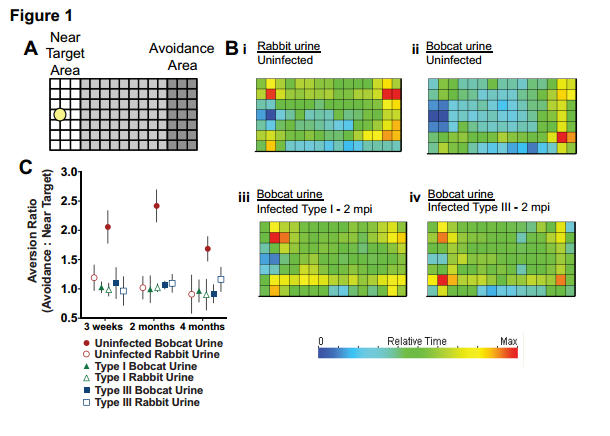All animals live in a microbe rich environment, with immense numbers of bacteria, archaea, fungi and other eukaryotic microbes living in, on and around them. For some of these microbes, the association is transitory and unimportant, but many make animals their permanent home, or interact with them in ways that are vital for their survival.
Many members of an animal’s “microbiome” are affected by, and often become dependent on, aspects of the animal’s behavior. And, as microbes will do, some – and we believe many – of these microbes have evolved specific ways to manipulate the behavior of their animal neighbors to their advantage.
My lab has begun to study several such systems, seeking to discover the molecular mechanisms that underly these fascinating microbial adaptations – none of the several dozen cases in which microbial manipulation of animal behavior has been documented are understood in molecular detail.
One of these systems involves the eukaryotic parasite Toxoplasma gondii which reproduces clonally in most (if not all) warm blooded animals, but – for unknown reasons – only reproduces sexually in the digestive system of cats. Thus, in order to complete the Toxo lifecycle, an infected animal has to be eaten by a cat. This creates a conflict of interest between Toxo, who wants its host to be eaten by a cat, and the host, who would rather NOT be eaten by a cat. Indeed this “I don’t want to be eaten by a cat” effect is so strong, that many animals have evolved an innate fear of all things cat – especially their smells.
For example, if you take a laboratory mouse and put him (for a variety of reasons we usually do these experiments with males) in a box with a bowl or water they will largely ignore it. Swap out the water and put in something that the mouse has no reason to fear – like rabbit urine – and they still more or less ignore it. Swap that out and put in cat urine, and it’s a whole different ball game – the mouse spend most of its time on the other side of the cage.
Amazingly, it seems that rodents infected with Toxo lose this innate fear of cats – possibly as a result some property Toxo has evolved to increase the likelihood that it will end up in a cat’s tummy. Several papers have come out on the topic in recent years (from Robert Sapolsky’s lab at Stanford as well as others), but the molecular mechanism is unknown.
A graduate student – Wendy Ingram – became obsessed with this phenomena and is pursuing it as a joint project between my lab and that of Ellen Robey (an immunologist who studies the host response to Toxo infection and the ways the parasite evades immune surveillance). Wendy has begun a bunch of experiments to examine this phenomenon – she is interested, in particular, in the role the immune system might play in mediating this response. Her first wave of experiments is done, and we have posted a preprint of a paper describing them on the arxiv.
Wendy first showed that the behavioral effect is robust, and is general across Toxo (previous experiments had used only one of the three major North American variants of Toxo – Wendy showed the same effect in the other two subtypes. But more interestingly, Wendy found that the effect was strong and persists for months in an attenuated Toxo strain that – unlike the other strains we and others have examined – is not detectable in the brains of infected animals after a few weeks. This would seem to refute – or at least make less likely – models in which the behavior effects is the result of direct physical action of parasites on specific parts of the brain.
Assessment of aversion demonstrates loss of fear toward cat urine in Type I- and Type III-infected mice. [A] Overhead representation of behavioral arena where a small dish containing the ‘target’ solution (yellow disk) is affixed at one end of the behavioral arena. ‘Near Target’ is defined as the area of the arena (white) proximal to the target. ‘Avoidance’ is defined as the most distal region (dark grey) of the enclosure relative to the target. [B] Representative heat maps of mouse place preference during a 60-minute trial of (i) uninfected mice exposed to rabbit urine, and (ii) uninfected, (iii) Type I-infected, and (iv) Type III-infected mice exposed to bobcat urine from trials conducted at 2 months post infection. [C] Aversion ratio, the avoidance time to near target time, of uninfected (red circles), Type I-infected (green triangles), and Type IIIinfected (blue squares) animals when exposed to bobcat urine (filled shapes) or rabbit urine (open shapes) at 3 weeks, 2 months, and 4 months post infection. Error bars are the Standard Error of the Mean (SEM). Credit: arXiv:1304.0479
It’s just a start in trying to dissect a complicated phenomenon, but Wendy has a whole slew of followup experiments under way or in planning that should shed more light on what aspects of the innate fear response are being overridden and what, if any, role the immune system is playing.
As always, we welcome your thoughts and comments on the paper, released here as part of our commitment to make preprints of all of our lab’s papers available as soon as (if not before) we’re ready to submit them to a journal, and to make them available here for open peer review.
Citation: Wendy Marie Ingram, Leeanne M Goodrich, Ellen A Robey, Michael B Eisen, 'Low-virulence Strains of Toxoplasma gondii Result in Permanent Loss of Innate Fear of Cats in Mice, Even after Parasite Clearance', arXiv:1304.0479
Originally appeared on MichaelEisen.org, April 2nd, 2013





Comments